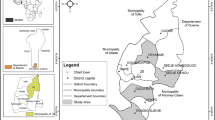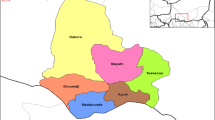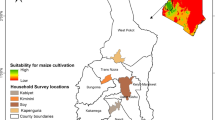Abstract
The world has been experiencing a tremendous increase in the average of warmth and shifts in rainfall quantity, seasonality, and occurrence of prolonged droughts, increased temperatures and intense precipitation. This study assessed effective adaptation strategies used by maize growers in cushioning climate change impacts in Iringa district. Both qualitative and quantitative data were collected. Qualitative data were collected through focus group discussions, key informant interviews and participant observations, while quantitative data were collected using household questionnaire. Both qualitative and quantitative data were collected covering a wide range of climate change impacts and response strategies. We found that maize production has decreased during the past two decades, since the year 2000 (i.e., from the average of 10–15 to 2–5 maize sacks per acre). It was affirmed that increased yield outputs and incomes are among the key determinants for the effectiveness of a response strategy. Findings indicate that some response strategies indicated a significant increase in maize crop yield. Such responses include using improved maize variety (P = 0.000 (P < 0.05), drought-tolerant crop (P = 0.014 (P < 0.05), changing planting dates (P = 0.001 (P < 0.05) and crop rotation (P = 0.000 (P < 0.05). Barriers such as access to capital, poor farming technologies, absence of improved maize agencies or shops, poor access to weather information and high prices for farm inputs to adopting effective adaptation strategies were uncovered. Moreover, most adaptation strategies were found to significantly increase crop production to most of the household farmers, thus leading to high mazie production. Thus, maize growers need support to enhance their locally-led adaptation options to climatic impacts.




Similar content being viewed by others
References
ACT (2006) Tanzania Food Relief Assistance – AFTZ61 Appeal Target: US$ 741,141. 150 route de Ferney, Geneva 2, Switzerland
Action Aid Report (2006) Climate Change and Smallholder farmers in Malawi: Understanding poor people’s experiences in climate change adaptation. Action Aid International, London, p 8
Adesoji SA, Ayinde JO (2013) Ethno-Practices and Adaptation Strategies for the Mitigation of Climate Change by Arable Crop Farmers in Osun State: Implications for Extension Policy Formulation in Nigeria. J Agric Food Inf 14(1):66–76
Adger WN, Arnell NW, Tompkins EL (2005) Successful adaptation to climate change across scales. Global Environ Change 15:77–86
Ahmed MU, Maurya AK, Cheng L, Jorge EC, Schubert FR, Maire P, Basson MA, Ingham PW, Dietrich S (2017) Engrailed controls epaxial-hypaxial muscle innervation and the establishment of vertebrate three-dimensional mobility. Dev Biol 430(1):90–104
Akinnagbe OM, Irohibe IJ (2014) Agricultural Adaptation Strategies to Climate Change Impacts in Africa: A Review, Bangladesh. J Agric Res 39(3):407–418
Armah RNA, Ramatu MA, Kuwornu JKM, Osei-Owusu Y (2013) What influences farmers’ choice of indigenous adaptation strategies for agrobiodiversity loss in northern Ghana. Br J Appl Sci Technol 3(4):1162–1176
Barnett J, O’Neill S (2010) Maladaptation. Glob Environ Change 20:211–213
Belay A, Recha JW, Woldeamanuel T, Morton JF (2017) Smallholder farmers’ adaptation to climate change and determinants of their adaptation decisions in the Central Rift Valley of Ethiopia. Agric Food Security https://doi.org/10.1186/s40066-017-0100-1. [Accessed 9 Oct 2017]
Below T, Artner A, Siebert R, Sieber S (2010) Micro-level Practices to Adapt to Climate Change for African Small-scale Farmers. IFPRI Discussion Paper 00953. http://www.africa-adapt.net/media/resources/879/ifpridp00953.pdf. Accessed 17/07/2018
Below T, Mutabazi B, Kirschke D, Franke C, Sieber S, Siebert R, Tscherning K (2012) Can farmers’ adaptation to climate change be explained by socio-economic household-level variables? Glob Environ Change 22(1):223–235
Boko MI, Niang A, Nyong C, Vogel A, Githeko M, Medany B, Osman-Elasha RT, Yanda P (2007) Impacts, Adaptation and Vulnerability: Africa Climate Change’ Contribution of Working Group II to the Fourth Assessment Report of the Intergovernmental Panel on Climate Change, ML, Parry, OF, Canziani, JP, Palutikof, PJ, van der Linden & Hanson CE, (eds), Cambridge University Press, Cambridge UK, p 433–467
Boyde, HK, Westfall R, Stasch SF (1981) Market research, texts, and cases. Irwin, Homewood, Ill
Brooks S, Thompson J, Odame H, Kibaara B, Nderitu S, Karin F, Millstone E (2009) Environmental Change and Maize Innovation in Kenya: Exploring Pathways In and Out of Maize, STEPS Working Paper 36. STEPS Centre, Brighton
Bryan E, Deressa T, Gbetibouo G, Ringler C (2009) Adaptation to Climate Change in Ethiopia and South Africa: Options and Constraints. Environ Sci Policy 12:4
Carter KA, Beaulieu L (1992) Conducting A Community Needs Assessment. http://www.virtualcap.org/downloads/VC/US_Needs_Assessment_FL_Coop_Extension_Primary_Data_Collection_Techniques.pdf
Chamber JA (1998) Wanted: Foundations of Accounting Measurement. Int J Adapt Control Signal Process 12:95–96. https://doi.org/10.1111/1467-6281.00021
Clarke R (ed) (1986) The Handbook of Ecological Monitoring. Clarendon Press, Oxford
Cuculeanu V, Adriana M, Catalin S (1999) Climate change impact on agricultural crops and adaptation options in Romania. CLIMATE RESEARCH Clim Res 12:153–160. 1999, pp 156
Deressa TT, Hassan RM, Ringler C (2011) Perception of and Adaptation to Climate Change by Farmers in the Nile Basin of Ethiopia. J Agri Sci 149(1):23–31
Deressa TT, Hassan RM, Ringler C, Alemu T, Yesuf M (2009) Determinants of farmers’ choice of adaptation methods to climate change in Nile Basin of Ethiopia. Glob Environ Change 19(2):248–255
Dimmie BY (2016) Assessing the Effectiveness of Agricultural Households’ Strategies for Sustainable Adaptation to Climate Change in the Sissala East District. Dissertation University of Ghana, Ghana
Eriksen S, O’Brien K (2007) Vulnerability, poverty and the need for sustainable adaptation measures. Clim Policy 7:337–352
Eulenstein F, Marcos AL, Sandro LS, Askhad KS, Marion T, Axel B, Edgardo G, Santiago M (2016) Regionalization of Maize Responses to Climate Change Scenarios, N Use Efficiency and Adaptation Strategies. Horticulturae 3(1):9
Frida (2016) Adaptation strategies to climate variability and climate change; Impacts on food security among smallholder farmers in Moshi Rural District, Kilimanjaro Region, Tanzania: Perceptions, Capacities and Limitations of adaptive strategies. Dissertation, Aarhus University-Denmark
Gelmesa D (2018) Promoting Drought and Heat Resilient Potato Genotypes in Eastern Ethiopia. Haramanya, Ethiopia
Gota RC (2016) An Assessment of Climate Change Adaptation Strategies For Chirumanzu District, Zimbabwe. Available at: http://ir.msu.ac.zw:8080/xmlui/bitstream/handle. [Accessed 25 July 2018]
Gyasi EA, Karikari O, Kranjac-Berisavljevic G, Vordzogbe V (2006) Climate change vulnerability and adaptation assessment relative to land management in Ghana. Reports of the Members of the Study Team, Accra
IIED (2016) Measuring effective and adequate adaptation. IIED, Gray’s Inn Road, London, p 7–11
IPCC (2007) Summary for Policy Makers. In: Parry MI, Canziani OF, Palutikof GP, van der Linden PJ, Hanson CE eds Climate Change 2007: Impacts, Adaptation and Vulnerability. Contribution of Working Group II to the Fourth Assessment Report. International Panel on Climate Change. Cambridge University Press, Cambridge
Jones EP (2001) Circulation in the Arctic Ocean. Polar Res 20(2):139–146. https://doi.org/10.3402/polar.v20i2.6510
Kalinda TH (2011) Smallholder Farmers’ Perceptions of Climate Change and Conservation Agriculture: Evidence from Zambia. J Sustain Dev 4:4. August 2011 Canadian Center of Science and Education
Kangalawe RYM, Mwakalila S, Masolwa P (2011) Climate Change impacts, local knowledge and coping strategies in the Great Ruaha River catchment area, Tanzania. Nat Resourc 2:212–223
Kangalawe RYM, Mung’ong’o CG, Mwakaje AG, Kalumanga E, Yanda PZ (2017) Climate change and variability impacts on agricultural production and livelihood systems in Western Tanzania. Clim Dev 9(3):202–216. https://doi.org/10.1080/17565529.2016.1146119
Kihupi ML, Mahonge C, Chingonikaya EE (2015) Smallholder Farmers’ Adaptation Strategies to Impact of Climate Change in Semi-arid Areas of Iringa District Tanzania. J Biol Agric Healthc 5(2):2015
Kijazi AL, Reason CJC (2012) Intra-seasonal variability over the north-eastern highlands of Tanzania. Int J Climatology 32:874–887
Komba C, Muchapondwa E (2015) Adaptation to Climate Change by Smallholder Farmers in Tanzania. Discussion Paper Series, Environment for Development June 2015, EfD DP 15-12
Kombo KD, Tromp LA (2006) Proposal thesis writing. Don Bosco Printers, Makuyu
Kothari C (2004) Research Methods and Techniques, 2nd Edition. Wesley Eastern Limited, New Delhi
La Rovere R, Abdoulaye T, Kostandini G, Guo Z, Mwangi W, MacRobert J, Dixon J (2014) Economic, production and poverty impacts of investing in maize tolerant to drought in Africa. J Dev Areas 48(1):199–225
Lin BB (2011) Resilience in agriculture through crop diversification: adaptive management for environmental change. Bioscience 61:183–193
Maddison D (2006) The Perception of and Adaptation to Climate Change in Africa. CEEPA Discussion Paper No. 10. Centre for Environmental Economics and Policy in Africa, University of Pretoria, South Africa
Mahauna A, Roland F, Dominique B (2018) Farmers’ Adaptation Strategies to Climate Change and Their Implications in the Zou Department of South Benin. Environments 5(1):15
Makate C, Wang R, Makate M, Mango N (2016) Crop diversification and livelihoods of smallholder farmers in Zimbabwe: Adaptive management for environmental change. SpringerPlus 5:2–18
Mazengo R (2011) Assessment of the Effectiveness and Sustainability of Household Food Insecurity Coping Strategies in Chamwino District Dodoma Region. Dissertation, Sokoine University of Agriculture. p 26–28. Morogoro, Tanzania.
Mgunang R, Rivington M (2009) Adaptation for crop agriculture to climate change in Cameroon: Turning on the heat. Mitig Adapt Strateg Glob Change 14:153–168
Mongi H, Majule A, Lyimo J (2010) Vulnerability and adaptation of rain-fed agriculture to climate change and variability in semi-arid Tanzania. Afr J Environ Sci Technol 4(6):371–381
Morris ML, Tripp R, Dankyi AA (1999) Adoption and Impacts of Improved Maize Production Technology: A Case Study of the Ghana Grains Development Project, Economics Program Paper 99-01. CIMMYT, Mexico, D.F.
Msola DK (2007) The role of wild foods in household income and food security. Doctoral dissertation, Sokoine University of Agriculture, Morogoro, Tanzania, p 77
Mutekwa VT (2009) Climate change impacts and adaptation in the agricultural sector: the case of smallholder farmers in Zimbabwe. J Sust Dev Africa 11:237–256
Niang I, Ruppel OC, Abdrabo MA, Essel A, Lennard C, Padgham J, Urquhart P (2014) Climate Change Impacts, Adaptation, and Vulnerability. Part B: Regional Aspects. Contribution of Working Group II to the Fifth Assessment Report of the Intergovernmental Panel on Climate Change. Cambridge University Press, Cambridge, p 1199–1265
Njeru EM (2013) Crop diversification: a potential strategy to mitigate food insecurity by smallholders in Sub-Saharan Africa. J Agric Food Syst Community Dev 2013(3):63–69
Oluwaranti A, Fakorede MAB, Menkiri A (2015) Evaluation of late maturing maize varieties for late-season planting in a rainforest location of Nigeria. Int J Agri Res 7(4):111–116
Ouma E, Dione M, Lule P, Pezo D, Marshall K, Roesel K, Mayega L, Kiryabwire D, Nadiope G, Jagwe J (2014) Smallholder pig value chain assessment in Uganda: results from producer focus group discussions and key informant interviews. ILRI (Research Report). ILRI, Nairobi, Kenya, p 130
Pauline MN, Grab S (2018) Whose knowledge matters in climate change adaptation? Perceived and measured rainfall trends during the last half-century in south-western Tanzania. Department of Geography, National University of Singapore and John Wiley & Sons Australia, Ltd
Pauline MN, Coleen V, Grab S, Liwenga ET (2016) Smallholder farmers in the Great Ruaha River sub-Basin of Tanzania: coping or adapting to rainfall variability? Climate and Development, https://doi.org/10.1080/17565529.2016.1184607
Porter JR, Xie L, Challinor AJ, Cochrane K, Howden SM, Iqbal MM, Lobell DB, Travasso MI (2014) Food security and food production systems. In: Field CB, Barros VR, Dokken DJ, Mach KJ, Mastrandrea MD, Bilir TE, Chatterjee M, Ebi KL, Estrada YO, Genova RC, Girma B, Kissel ES, Levy AN, MacCracken S, Mastrandrea PR, White LL (eds.) Climate Change 2014: Impacts, Adaptation, and Vulnerability’ Part A: Global and Sectoral Aspects. Contribution of Working Group II to the Fifth Assessment Report of the Intergovernmental Panel on Climate Change. Cambridge University Press, Cambridge, United Kingdom and New York, NY, USA, p 485–533
Pritchard K (2011) “From “being there” to “being […] where?”: relocating ethnography”. Qualitative Res Organ Manag 6(3):230–245. https://doi.org/10.1108/17465641111188402
Rowhani P, Lobell DB, Linderman M, Ramankutty N(2011) Climate variability and crop production in Tanzania. Agric For Meteorol 151(2011):449–460. 2010 Elsevier B.V.
Simbarashe G (2013) Climate change, variability and sustainable agriculture in Zimbabwe’s Rural Communities. Russian J Agric Socio-Economic Sci 2(14):89–100
Thontorn N (2011) Climate Change Financing and Aid Effectiveness. Tanzania Case Study. http://www.oecd.org/htm/M0053.htm, accessed 10/10/2017
Thornton PK, Jones PG, Ericksen PJ, Challinor AJ (2011) Agriculture and food systems in sub‐Saharan Africa in a four‐plus degree world. Philos Trans R Soc Ser A 369:117–136
Ulstrud K, Sygna L, O’Brien K (2008) More than Rain: Identifying Sustainable Pathways for Climate Adaptation and Poverty Reduction. The Development Fund, Oslo
URT (2003) Agricultural Sector Development Programme, Framework and Process Document. Government Printer, Dar es Salaam, Tanzania, p 54
URT (2007) National adaptation plan of action (NAPA). Vice President’s Office. Division of Environment. Government printers, Dar es Salaam, p 52
URT (2013) The 2012 Population and Housing Census: Population Distribution by Administrative Areas. National Bureau of Statistics Ministry of Finance Dar es Salaam and Office of Chief Government Statistician President’s Office, Finance, Economy and Development Planning Zanzibar
URT (2015) Budget Speech of the Minister of Lands to Parliament for Financial Year 2015/2016. Government Printer, Dar es Salaam
Vrieling A, de Leeuw J, Said MY (2013) Length of Growing Period over Africa: Variability and Trends from 30 Years of NDVI Time Series. Remote Sens 5:982–1000
Waongo M, Laux P, Kunstmann H (2015) Adaptation to climate change: the impacts of optimized planting dates on attainable maize yields under rainfed conditions in Burkina Faso. Agri Forest Meteorol 205:23–39
World Bank (WB) (2011) World development indicators. World Bank, Washington DC, http://ddp-ext.worldbank.org/ext/DDPQQ, accessed 10/10/ 2017
Author information
Authors and Affiliations
Corresponding author
Ethics declarations
Conflict of Interest
The authors declare no competing interests.
Additional information
Publisher’s note Springer Nature remains neutral with regard to jurisdictional claims in published maps and institutional affiliations.
Rights and permissions
About this article
Cite this article
Shabani, Y., Pauline, N.M. Perceived Effective Adaptation Strategies against Climate Change Impacts: Perspectives of Maize Growers in the Southern Highlands of Tanzania. Environmental Management 71, 179–189 (2023). https://doi.org/10.1007/s00267-021-01563-x
Received:
Accepted:
Published:
Issue Date:
DOI: https://doi.org/10.1007/s00267-021-01563-x




